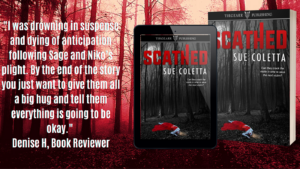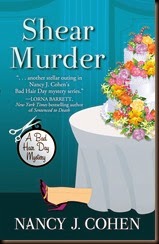By Sue Coletta
 Lately, I’ve been consumed with creating a series bible for my Grafton County Series. So, I thought I’d share some tips to help you avoid making the same mistakes. Mistakes like thinking highlighted notes on my Kindle were enough to jog the ol’ memory bank. Mistakes like scribbling notes on scrap paper or a whiteboard. Mistakes like tabbing umpteen pages in the previous paperbacks.
Lately, I’ve been consumed with creating a series bible for my Grafton County Series. So, I thought I’d share some tips to help you avoid making the same mistakes. Mistakes like thinking highlighted notes on my Kindle were enough to jog the ol’ memory bank. Mistakes like scribbling notes on scrap paper or a whiteboard. Mistakes like tabbing umpteen pages in the previous paperbacks.
Yep. I’ve done all of the above and more. Hence why I’ve had to reread every book in the series. It’s been months since I’ve written in the Grafton County Series. When I set out to plan my WIP, I’d forgotten a lot of details. In my defense, I did write a true crime book, another Mayhem Series thriller, and new true crime proposal in between.
Though it’s fun to spend time with my characters, it’s also a ton of added work, work that could’ve been avoided if I had a series bible in place. Don’t be like me. Even if you’re writing book one, start your series bible now.
Format
We first need to decide on a format for our series bible. Some writers use Scrivener. Others prefer Evernote or a Word.doc. The most popular choice is to print the series bible and organize in a three-ring binder. Pick the format that works best for you.
Organize by Color
Choose one color for each book in the series. Every detail you list in the series bible should correspond to the book’s color.
Example…
Book 1: Blue
Book 2: Red
Book 3: Purple
Book 4: Green
By color-coding, if you need a detail from the series bible while writing, one glance will tell you when the fact occurred.
Details to Include
- Description of main characters
- Description of secondary characters
- Description of villains, including monikers (if applicable)
- Victims
- Characters’ profession
- Killers MO (if applicable)
- Pets, including deceased pets (if applicable)
- Tattoos/piercings (if applicable)
- Scars, emotional and physical
- Jewelry
- Marital status/relationships
- Important dates
- Family ties
- Themes
- Setting
- Backstory
- Housing
- Accent (if any)
- Décor
- Cherished treasures
- Timelines
- Future scene ideas
Most of the above list is self-explanatory, but I do want to point out a few things.
Character Description
An important part of the series bible is character description. Savvy readers will notice if your MC has a small ankle tattoo from her college days in book one, then claims s/he’d never be stupid enough to get one in book five or six.
In this section be sure to include the basics: hair & eye color, height & weight (approximate, if you’ve never detailed this attribute), style of dress, skin tone/complexion, tattoos & piercings (if applicable), favorite perfume/cologne, injuries and physical scars.
When I listed Sage’s injuries/physical scars, I couldn’t believe what I’d done to this poor woman. Here’s a small sample from my story bible.
- thick neck scar that tugs at the skin
- white lines zigzagging across her right forearm
- lost unborn child from rape
- scar from incised wound on right wrist
- orbital floor fracture (broken eye socket)
- fractured cheekbone
- broken nose
- faint scar from stitches on left wrist
- faint scar from stitches on upper lip
- faint scar from stitches on right cheek
- faint scar from stitches on forehead
And that’s only the first two books!
Emotional Turmoil
Since I write psychological thrillers, it’s vitally important for me to track each character’s emotional toll. Past experiences define and shape our characters into the people they are today. An emotional sketch of each character allows us to find triggers and/or weaknesses to exploit in future books. *evil grin*
Incidentally, I do the same for pets. For example, Sage and Niko have two dogs, Colt and Ruger. These dogs have lived through harrowing experiences, and they’ve developed certain habits that stem from those experiences. Animals feel things as deeply as we do. If the pets emerge unscathed, the characterization won’t ring true.
Details
Tiny details matter. For example: When Sage gets nervous, she plays with a Gemini pendant, sliding it back and forth across the necklace. Now, the pendant is turquoise and silver, but for some reason, I wrote “gold” chain in book one. Because this necklace holds sentimental value, Sage would never switch the pendant to a different chain. This minor detail has never been a problem for me. Rarely, if ever, do I mention the color of the chain. Too much description slows the pace.
But what if I decide to kill her some day? Or fake her death? That necklace could become a key piece of evidence. See what I’m sayin’? Even if we never intend to use the minor detail when we list it, we still should include it in the series bible in case we change our mind.
Smell
The nose knows! In my Grafton County Series, the medical examiner practically bathes in Aramis cologne. Anyone within fifteen feet knows he’s entered the crime scene before they ever spot him. It’s become a running joke. I could never forget that detail, but I still include it in the series bible under his name just in case.
What did slip my mind was Sage’s perfume. This might not sound like a big deal, but for this series, it’s an important detail. During tender moments, Sage’s husband Niko breathes her in. The soft aroma of Shalimar mushrooms across his face, with notes of lemon, iris, jasmine, rose, patchouli, sandalwood, and vanilla. He loves that about her. If I didn’t include this detail in the series bible, future books wouldn’t ring true.
Side tip: If you’re struggling for a scent, ask your husband/wife or significant other. We all have a scent that’s uniquely ours. Maybe they love your shampoo, skin cream, body wash, after-shave, or scented deodorant. Once you find the answer, transfer that scent to your lead or secondary character. Or show your character cooking, baking, or eating. Food is an easy way to include one of the most under-appreciated senses in fiction: smell. If the character is eating, be sure to include taste, too. Bonus!
Décor
Does your character have a favorite chair? List it in the series bible.
Does your character hate the hard sofa? Jot down why in the series bible.
Did you focus in on an antique timepiece or cuckoo clock in a past book? Describe it in the series bible.
What about a wall safe or gun cabinet? Be sure to include the combination in the series bible.
Example: After a hard day at work, Niko collapses in his Lay-Z-Boy. I’ve never described the recliner in detail. Never had a reason to. Instead, I simply wrote “Lay-Z-Boy” under Niko’s name in the series bible.
He also has a favorite coffee mug, with #1 Dad inscribed on a gold shield. If Sage poured his coffee into a different mug, fans of the series would wonder where it went.
Minor details can impact series characters in an emotional, conflict-driven way.
What if Sage came home to find Niko’s mug shattered on the kitchen floor? Better yet, what if she found it on the bedroom floor? I’ve made it a point to mention this mug in every book. It’s a Grafton County series staple. One glimpse of the shattered mug, and Sage would leap to the conclusion that someone’s been in the house. In reality Colt or Ruger might have knocked it off the counter or bureau. How it wound up on the floor isn’t important (yet). What is important is that I’ve created conflict just by showing the shattered mug.
Future Scenes
A funny thing happens while creating a story bible. Scene ideas flood the creative mind. While working on my series bible, not only have I finished planning my next Grafton County Series thriller, but I gained at least one new premise for a future book, as well. I even stormed through writing the first few chapters of my WIP. And that may be the best reason of all to create a series bible—to get the creative juices pumping in the right direction.
Can’t think of a plot for your next WIP? Review the story bible. It’s a lot easier than re-reading the entire series. Trust me on that. 🙂

Need tips for writing a series? Check out the group TKZ post.
Do you use a series bible? If you do, any tips to share? If not, what’s your process to ensure consistency throughout the series?
 His name is Paradox and he poses his victims in RED cocktail dresses, RED roses in place of eyes. He will kill again if his riddles aren’t solved within 24 hours.
His name is Paradox and he poses his victims in RED cocktail dresses, RED roses in place of eyes. He will kill again if his riddles aren’t solved within 24 hours.
Can Niko and Sage stop him before the clock runs out?
Look Inside SCATHED: https://books2read.com/SCATHED



